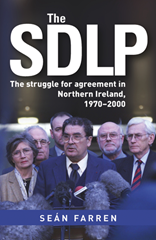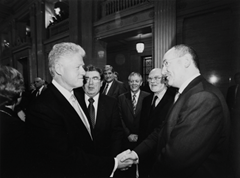The SDLP’s turbulent history
 The SDLP was founded during the most turbulent period of Northern Ireland’s political history. Author Seán Farren speaks to Emma Blee about the party’s struggle to date.
The SDLP was founded during the most turbulent period of Northern Ireland’s political history. Author Seán Farren speaks to Emma Blee about the party’s struggle to date.
More than 40 years ago the SDLP was founded in an attempt to improve civil rights but in the early days many within the political arena dismissed the party and were sceptical about how long it would survive.
Party member Seán Farren has now published ‘The Struggle for Agreement in Northern Ireland 1970-2000’ which, he says, records the “resolute commitment” of the party over the years.
It is the first book penned about the SDLP by an insider and most of it focuses on the work of John Hume and Seamus Mallon and their rocky journey through politics in Ireland.
The book is intensely detailed and outlines the many challenges that the party has faced, including Bloody Sunday, which “changed everything” for Northern Ireland, the collapse of the Sunningdale Agreement and controversial talks with Gerry Adams. But while there is a sense of frustration and turmoil in the early chapters of the book, hope almost always shines through with events such as Hume’s election to the European Parliament, the signing of the Anglo-Irish Agreement and the Good Friday Agreement.
Farren joined the party in 1972 and served as a member of its Executive for more than 10 years, where he was appointed vice- chair and eventually chair. He was also elected in various assembly elections in the 1980s and 1990s for North Antrim. Terms as Minister of Higher and Further Education, Training and Employment and Minister of Finance and Personnel followed in the first power sharing Executive, before he retired from electoral office in 2007.
Speaking about his book, he explains that it was his passion for Irish history combined with a lack of political commentary on the SDLP that motivated him to write the account: “I had been looking at the considerable literature that exists on the political situation in Northern Ireland and I was struck by the fact that there was hardly anything about the SDLP. There was nothing written about the party’s role as such.”
Throughout it, he portrays the SDLP as a party that is different to any of the others. He notes that before the party was founded there was a “plethora of political parties” within the nationalist community. However, the former MLA believes the SDLP is “a party that is much more progressive and more coherently organised” than the other parties.
It broke the “old tradition of simply blaming the British for the problems that existed in Ireland and Northern Ireland in particular”. Instead, it suggested that the province should work for a “new and more positive relationship” between communities.
Farren adds that the SDLP is different from Sinn Féin as it is not a party of “confrontation” but works for reconciliation. Their policies are also very different: “We just didn’t emphasise the need for a political solution, in addition to that we emphasised the need for social and economic policies that would work to the benefit of the people in Northern Ireland and Ireland as a whole.”
The Good Friday Agreement is one of the most important events in the party’s history and is, in some ways, the most central issue of the book. While the Agreement was warmly welcomed by the SDLP, there was frustration that it had taken so long to agree on what the party believed was mostly set out in the 1973 Sunningdale Agreement. Within the book, Farren writes: “Séamus Mallon ruefully summed up many people’s feelings when he described the Good Friday Agreement as ‘Sunningdale for slow learners’.”
While the former politician says he enjoyed working on the book and it “wasn’t a difficult one to write”, he experienced a deep sadness when looking back at past events.
 “I worked through it and looked back and wondered why so many people were sent to early graves? Why were so many people injured? And why was so much property destroyed and so many opportunities, economic and otherwise, lost and destroyed by people who were using violence for something that couldn’t possibly be achieved by means of violence?”
“I worked through it and looked back and wondered why so many people were sent to early graves? Why were so many people injured? And why was so much property destroyed and so many opportunities, economic and otherwise, lost and destroyed by people who were using violence for something that couldn’t possibly be achieved by means of violence?”
With a gap of 11 years from where the book ends, Farren says the fact that the Good Friday Agreement is still in place and “we are all operating on the same basic principles” highlights that the party is as
relevant now as it ever was. While the Agreement persists, the SDLP can be regarded as the “successful architects of the agreement”, he contends.
However, he explains that after 2000, its implementation did not prove any easier than it had during its first year-and-a-half. He acknowledges that the SDLP faces a “challenging future” but argues that “despite its electoral setbacks, the party is still a significant player” in Irish politics and represents a significant section of the community.






